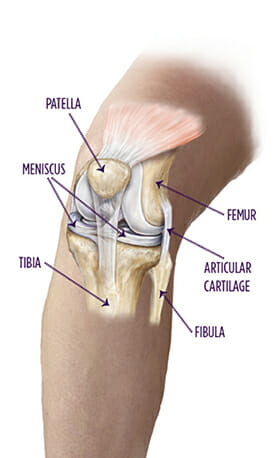What is a meniscus tear?
Tears of the meniscus, a rubbery, C-shaped disc that cushions your knee, are a common knee injury. Each knee has two menisci (plural of meniscus), one at the outer edge of the knee and one at the inner edge. With proper diagnosis, treatment, and rehabilitation, you’ll often be able to return to your pre-injury abilities.
What causes a meniscus tear?
A meniscus tear is usually caused by twisting or turning quickly, often with the foot planted while the knee is bent. These tears can occur when you lift something heavy or play sports. As you get older, degenerative changes of the knee may contribute to a torn meniscus.
What are the symptoms of a torn meniscus?
A torn meniscus causes the following symptoms:
- A popping sensation
- Swelling or stiffness
- Pain, especially when twisting or rotating your knee
- Limited motion of the knee joint
How are meniscal tears diagnosed?
Often, a torn meniscus can be identified during a physical exam. Your doctor may manipulate your knee and leg bones into different positions to help pinpoint the cause of your signs and symptoms. X-rays are typically done to assess for arthritis or bony injuries, and an MRI is done to confirm injury to the meniscus.
How is a torn meniscus treated nonsurgically?
Treatment for a torn meniscus depends on the severity and location of the tear, your age, and your activity level. Many meniscus tears will improve with nonoperative management alone. Treatment typically begins conservatively. Your doctor may recommend:
- Rest
- Ice
- Anti-inflammatory medication
- Cortisone injections
- Physical therapy to strengthen the muscles around the knee and in your legs to help stabilize and support the knee joint
- Arch supports or other shoe inserts to distribute force more evenly around your knee or decrease stress on certain areas of your knee
What are the surgical treatment options for a torn meniscus?
If nonsurgical treatments are not successful, your doctor may recommend knee arthroscopy. Arthroscopy is a minimally invasive operation in which the surgeon examines the joint with an arthroscope, a pencil-thin device equipped with a camera lens and light, and trim out or repair tears in the meniscus through a small incision. Decision to repair or trim out tears is based on the type of tear, location of the tear, quality of the tissue, and patient factors. Some repair techniques require another incision to aid in the repair.
After surgery, your doctor may put your knee in a brace to keep it from moving while healing.

